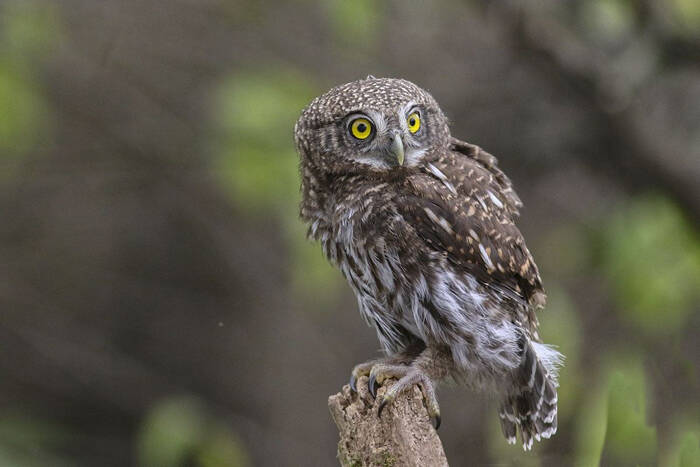Glaucidium passerinum
IUCN
LCBasic Information
Scientific classification
- name:Glaucidium passerinum
- Scientific Name:Glaucidium passerinum, Eurasian Pygmy Owl
- Outline:Raptor
- Family:Strigiformes Ostridae Owl
Vital signs
- length:15-17cm
- Weight:48.7-65.5g
- lifetime:About 10-20 years
Feature
Small in size, but fierce in temperament
Distribution and Habitat
The flower-headed owl is found in Lesser Khingan Mountains, Wuying, Genhe, Harbin, Liangshui in Heilongjiang Province and Dongling in Hebei Province in China. Outside China, it is distributed in northern Eurasia, from the Scandinavian Peninsula in northern Europe in the west to the Pyrenees, Spain and Italy in the south, and east through the central part of the former European Soviet Union, Siberia, Mongolia to the Okhotsk Coast and Sakhalin Island.
The flower-headed owl inhabits coniferous forests and mixed coniferous and broad-leaved forests. It is also found in open areas in forests and poplar and birch forests.
Appearance
The facial disk is not obvious and there are no ear tufts. The eye first and eyebrow lines are white, the eye first feather shafts are black and extend into hair whiskers, and the ear feathers are grey-brown with white horizontal spots. The upper body is mostly grey-brown, with white spots densely scattered on the head, back and shoulders. Among them, the spots on the top of the head are dense, and the spots on the back and shoulders become large and sparse, and are slightly horizontal spots; there is a row of larger white spots on the back of the neck, forming A less obvious collar spot. The upper wing coverts are similar to the back, but the white spots are larger; there are larger white spots on the outer part of the middle coverts, forming a white wing spot. The flight feathers are dark brown, with tan at the base, and white horizontal spots on the inner and outer feathers, with the inner feathers being larger; the secondary flight feathers are similar to the back, with white horiz
Details
The Eurasian Pygmy Owl is a small bird with two subspecies.

The Eurasian Pygmy Owl is mostly nocturnal, hiding deep in the forest during the day and difficult to see, but sometimes it is active and foraging during the day. When perching, it often stands on a high branch to look out, and keeps curling its tail feathers upward. It has a ferocious temperament, with strong beaks and claws, and can hunt prey much larger than itself. It also has the habit of storing food in winter, and often stores the food it hunts in tree holes. It mainly feeds on rodents, but also eats lizards, small birds and insects. When flying, it rises and falls in waves like a woodpecker. The call is a soft whistle "hjunk", which is repeated about every two seconds at dawn and dusk. The female bird's call is similar but with a heavier nasal sound. The call is different in autumn, a series of screams with increasing pitch.
The breeding season of the flower-headed owl is from May to July. It usually nests in tree holes, and also builds nests between large tree branches. Each nest lays 4-6 eggs, occasionally up to 8-9 and as few as 3. The eggs are white and 27-31 mm × 22-24 mm in size. The female bird is responsible for incubation, and the incubation period is 28-29 days.
The distribution range of the flower-headed owl is wide, and it is not close to the vulnerable and endangered critical value standard for species survival (distribution area or fluctuation range less than 20,000 km², habitat quality, population size, and fragmented distribution area), so it is evaluated as a species of least concern.
The flower-headed owl has been listed in the 2012 Red List of Endangered Species of the World Conservation Union (IUCN) ver 3.1-Least Concern (LC).
The flower-headed owl has been listed in the Appendix II of the Washington Convention on International Trade in Endangered Species of Wild Animals.
The flower-headed owl has been listed in the Class II protected animal in the List of National Key Protected Wildlife issued by the Ministry of Forestry and the Ministry of Agriculture of China on January 14, 1989.
Protect wild animals and stop eating game.
Maintaining ecological balance is everyone's responsibility!








